Harris’s Hawk (Parabuteo unicinctus), a captivating bird of prey native to the Americas, embodies a unique blend of striking features and social behaviors.
Renowned for its cooperative hunting nature, this medium-sized raptor draws attention with its distinctive dark and chestnut-brown plumage, adorned by a conspicuous white-banded tail.
Unlike many solitary raptors, Harris’s Hawk showcases an unparalleled familial bond, often hunting and roosting in cohesive family units. Found in diverse ecosystems, from arid deserts to grasslands, its adaptability contributes to a wide-ranging distribution.
Beyond its physical attributes, Harris’s Hawk is a vocal communicator, emitting distinct calls that play a crucial role in its cooperative hunting strategy.
This introduction sets the stage for an exploration of the intriguing life history, behaviors, and ecological significance of this remarkable avian species.
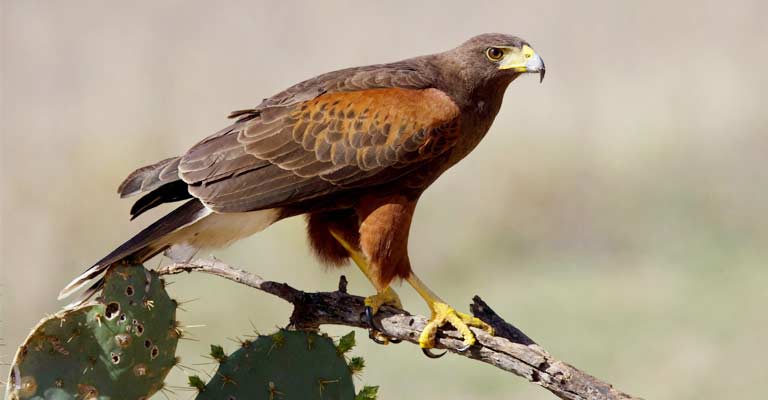
Identifying Characteristics of Harris’s Hawk
Harris’s Hawk (Parabuteo unicinctus) is a distinctive and sociable raptor, easily recognizable due to several identifying characteristics.
Understanding these features is crucial for bird enthusiasts, researchers, and wildlife observers alike.
Size and Structure
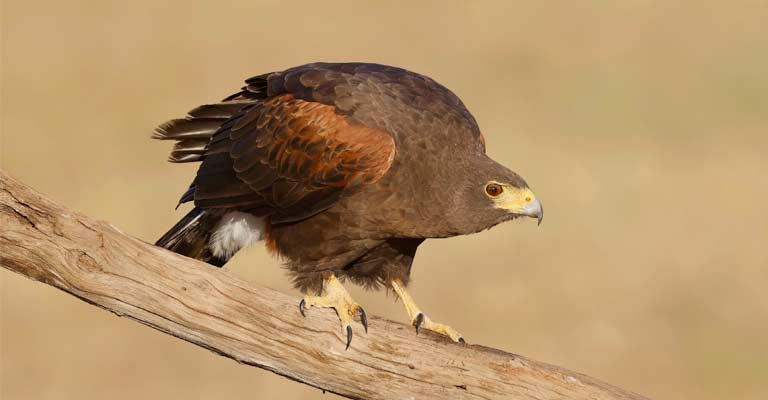
Harris’s Hawks are medium-sized birds of prey, measuring around 18 to 22 inches in length, with a wingspan ranging from 3.3 to 3.9 feet.
They have a robust build, broad wings, and a relatively long tail, contributing to their overall agile and powerful appearance.
Plumage and Coloration
The plumage of Harris’s Hawks is predominantly dark brown on the upperparts, while the underparts exhibit a lighter chestnut-brown.
Their legs are yellow, and the cere (the soft, fleshy skin at the base of the upper beak) is typically yellow or orange. The tail is long with a white band towards the tip, making it a key feature for identification, especially in flight.
Distinctive Face Markings
A distinguishing feature of Harris’s Hawks is the dark facial markings. They possess a dark cap on the head, which contrasts with a white patch on the forehead.
The facial pattern creates a distinctive “hooded” appearance, aiding in quick and accurate identification.
Yellow Legs and Cere
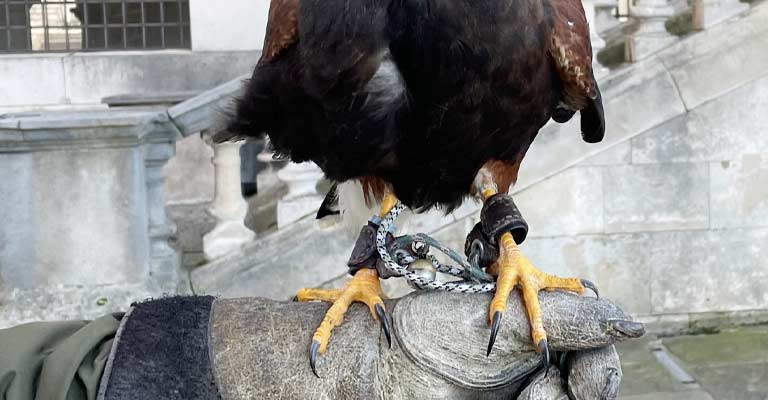
The bright yellow coloration of the legs and cereals is a notable characteristic. The cere, in particular, is a fleshy structure that covers the base of the upper beak and houses the nostrils.
The vibrant yellow coloration makes it stand out against the bird’s dark facial markings.
Social Behavior
Harris’s Hawks are known for their unique and cooperative hunting behavior. Unlike many other raptors, they often hunt in groups, forming family units.
This social nature, with individuals perched closely together, is a behavior not commonly observed in other hawks.
Distinctive Call
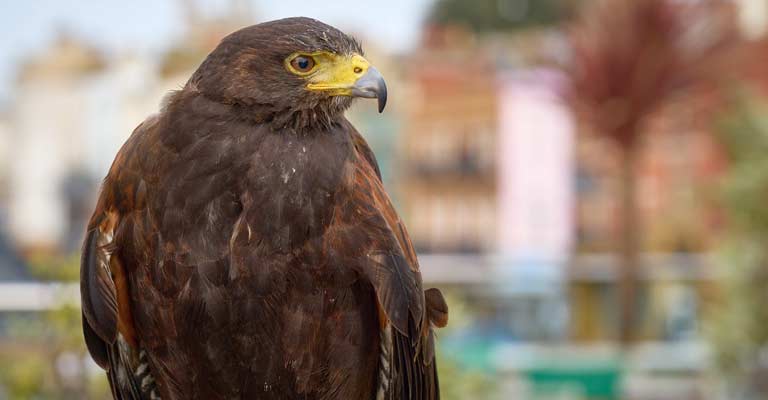
Their vocalizations include a variety of sharp, high-pitched calls. The most common call is a two-syllable, raspy scream, often described as a “kek-kek-kek.”
Familiarizing oneself with their vocalizations can aid in identifying these hawks even when they are not immediately visible.
Hunting Behavior
Observing their hunting style is another key to identification. Harris’s Hawks are known for cooperative hunting, where they work together to flush out and capture prey.
This behavior sets them apart from many other raptors that typically hunt alone. Their adaptability to various environments contributes to their widespread distribution in the Americas.
Recognizing Harris’s Hawk involves a combination of physical characteristics, behavioral traits, and habitat preferences.
The interplay of distinctive plumage, facial markings, and social behaviors makes this raptor a fascinating and easily identifiable species for those keen on bird observation and study.
Taxonomy of Harris’s Hawk
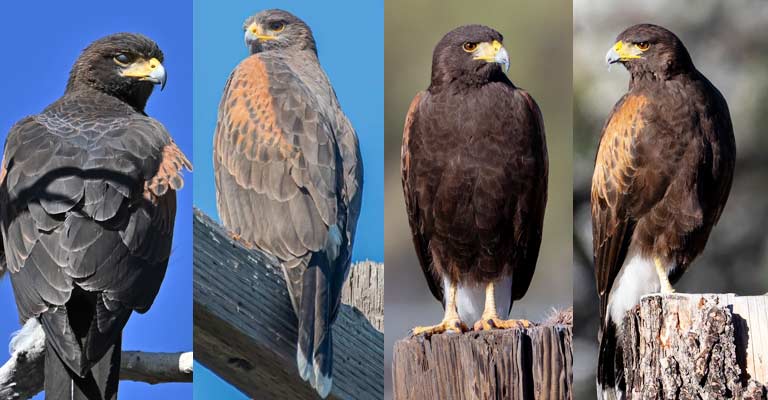
Here is a table outlining the taxonomy details of Harris’s Hawk (Parabuteo unicinctus):
| Taxonomic Rank | Classification |
| Domain | Eukaryota |
| Kingdom | Animalia |
| Phylum | Chordata |
| Class | Aves |
| Order | Accipitriformes |
| Family | Accipitridae |
| Genus | Parabuteo |
| Species | P. unicinctus |
This table provides an overview of the hierarchical classification of Harris’s Hawk based on its domain, kingdom, phylum, class, order, family, genus, and species.
Harris’s Hawk (Parabuteo unicinctus) belongs to the domain Eukaryota, kingdom Animalia, phylum Chordata, and class Aves. It is classified under the order Accipitriformes and family Accipitridae.
The genus of this hawk is Parabuteo, and its species is Unicinctus. This species is notable for its cooperative hunting behavior and is commonly found in the Americas.
The taxonomy reflects its position in the broader spectrum of life, highlighting its avian nature within the chordates and its specific characteristics among raptors in the Accipitridae family.
Harris’s Hawk Life History
Harris’s Hawk (Parabuteo unicinctus), a remarkable and sociable raptor, boasts an intriguing life history characterized by unique behaviors and adaptations.
From its food preferences to nesting habits and conservation status, understanding the comprehensive life history of Harris’s Hawk provides valuable insights into the species.
Food
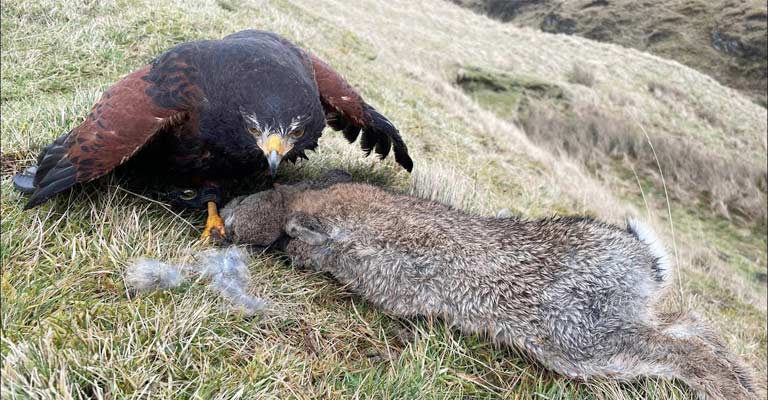
Harris’s Hawks exhibit a diverse diet, preying on small mammals, birds, reptiles, and even insects.
Their cooperative hunting strategy involves family groups working together to corner and capture prey. This distinctive behavior sets them apart from other raptors and contributes to their success in a variety of environments.
Habitat
Adaptable to various habitats, Harris’s Hawks are commonly found in arid and semi-arid regions, including deserts, grasslands, and scrublands.
Their versatility allows them to thrive in diverse ecosystems across the Americas, from the southwestern United States to South America.
Range Map
The range of Harris’s Hawk spans a vast territory, depicted in a range map that illustrates their distribution.
From the southwestern United States through Central America to the northern parts of South America, this species exhibits a broad and continuous presence.
Nesting
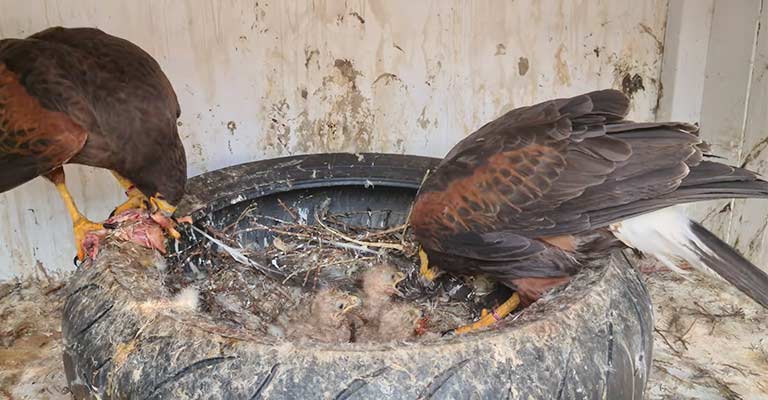
These hawks build nests in elevated locations such as trees, cacti, or even man-made structures. Nests are constructed with sticks and lined with softer materials.
The choice of elevated sites protects ground predators and facilitates a strategic vantage point for hunting.
Here’s a table summarizing nesting details of Harris’s Hawk (Parabuteo unicinctus):
| Nesting Details | Facts |
| Clutch Size | 2 to 4 eggs |
| Number of Broods | Typically 1 per year |
| Egg Length | Approximately 2.2 to 2.6 inches (5.6-6.6 cm) |
| Egg Width | Approximately 1.7 to 1.9 inches (4.3-4.8 cm) |
| Incubation Period | Around 28 to 35 days |
| Nestling Period | About 42 to 48 days |
| Egg Description | White to pale blue-green with occasional markings |
| Nest Location | Elevated sites, such as trees, cacti, or man-made structures |
| Nest Construction | Built with sticks and lined with softer materials |
| Parental Involvement | Both parents participate in incubation and care |
| Courtship and Mating Behaviors | Elaborate displays, aerial acrobatics, and mutual preening |
Breeding
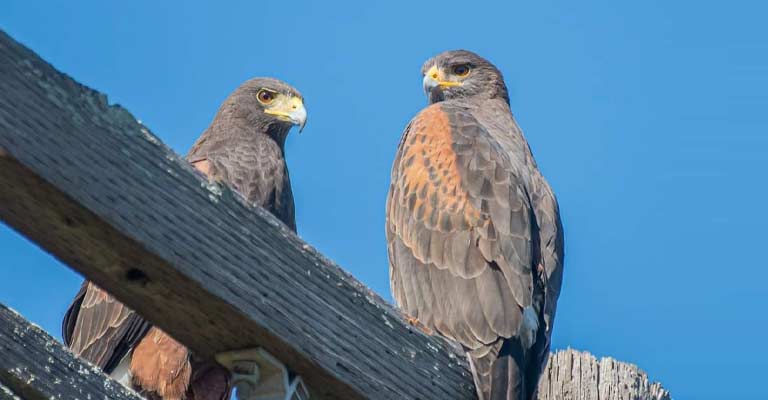
Breeding pairs engage in elaborate courtship displays, involving aerial acrobatics and mutual preening. After mating, the female typically lays 2 to 4 eggs, and both parents participate in incubation.
The chicks hatch after about a month, and parental care continues as the young hawks grow and develop.
Diseases
Like many bird species, Harris’s Hawks are susceptible to various diseases, including avian pox and parasitic infections. Monitoring their health is crucial for conservation efforts, as disease outbreaks can impact population dynamics.
Treatment
Veterinarians and wildlife rehabilitators play a vital role in treating Harris’s Hawks affected by diseases.
Rehabilitation efforts often involve medical treatment, quarantine measures, and, when possible, reintroduction into their natural habitat.
Conservation
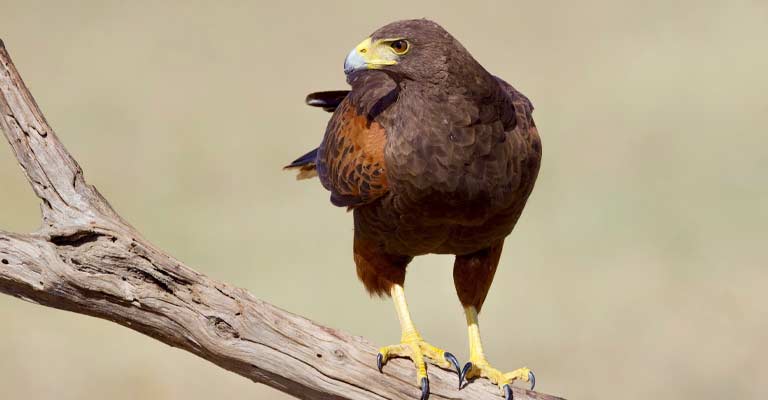
While Harris’s Hawks are not currently listed as endangered, habitat loss, human activities, and potential threats from pesticide exposure pose challenges.
Conservation efforts focus on preserving their natural habitats, educating the public about these birds, and monitoring populations to ensure their long-term survival.
The life history of Harris’s Hawk is a captivating narrative of adaptation, cooperation, and survival.
From their diverse diet and nesting behaviors to the challenges they face in the wild, understanding these aspects is crucial for the conservation and appreciation of this remarkable raptor species.
10 Fun Facts About Harris’s Hawk
Harris’s Hawk (Parabuteo unicinctus) is a fascinating bird of prey with a range of distinctive characteristics. Here are 10 fun facts about Harris’s Hawk:
- Social Hunters: Unlike many other raptors, Harris’s Hawks are known for their cooperative hunting behavior. They often hunt in family groups, strategizing and working together to capture prey.
- Diverse Diet: Harris’s Hawks are opportunistic hunters with a varied diet. They prey on small mammals, birds, reptiles, and even insects. This adaptability contributes to their widespread distribution across different ecosystems.
- Distinctive Plumage: These hawks have striking plumage, characterized by dark brown upperparts and chestnut-brown underparts. The long tail features a white band near the tip, providing a distinctive visual marker in flight.
- Versatile Habitat: Harris’s Hawks are highly adaptable, thriving in a range of habitats from deserts and grasslands to scrublands. Their ability to inhabit diverse environments has contributed to their success across the Americas.
- Vocal Communicators: They are known for their vocalizations, including a distinctive two-syllable, raspy scream often described as “kek-kek-kek.” Communication through calls plays a crucial role in their social structure and hunting activities.
- Family-oriented: These hawks exhibit strong family bonds. Family members often roost and hunt together, demonstrating a cohesive unit that cooperatively raises and cares for the young.
- Nesting in Unusual Sites: While they typically build nests in trees, Harris’s Hawks are adaptable and known to nest in a variety of locations, including cacti and man-made structures. This adaptability showcases their resourcefulness.
- Courtship Displays: Breeding pairs engage in elaborate courtship displays involving aerial acrobatics and mutual preening. These displays strengthen pair bonds and precede the nesting season.
- Longevity: In captivity, Harris’s Hawks can live for more than 20 years. However, their lifespan in the wild is typically shorter due to various environmental challenges and predation.
- Popular in Falconry: Harris’s Hawks are highly favored in the world of falconry due to their cooperative nature and ease of training. They are often used in hunting expeditions with human falconers, showcasing the strong connection between these birds and humans.
These fun facts highlight the remarkable characteristics and behaviors that make Harris’s Hawk a captivating and unique species in the avian world.
Wrapping Up
Harris’s Hawk, with its cooperative hunting, distinctive plumage, and adaptable nature, stands as a remarkable species in the avian kingdom.
From its family-oriented social structure to diverse hunting strategies, this bird of prey has carved its niche across a range of habitats.
The ability to thrive in various environments and form strong familial bonds contributes to the enduring charm of Harris’s Hawk, captivating bird enthusiasts and researchers alike.
Its unique characteristics, vocal communication, and adaptability underscore the importance of understanding and appreciating the life history of this fascinating raptor.